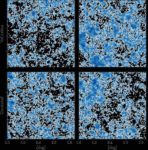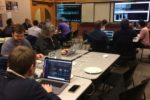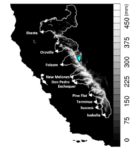As cosmologists and astrophysicists delve deeper into the darkest recesses of the universe, their need for increasingly powerful observational and computational tools has expanded exponentially. From facilities such as the Dark Energy Spectroscopic Instrument to supercomputers like Lawrence Berkeley National Laboratory’s Cori system at NERSC, they are on a quest to collect, simulate, and analyze […]
Video: Simulations of Antarctic Meltdown should send chills on Earth Day
In this video, researchers investigate the millennial-scale vulnerability of the Antarctic Ice Sheet (AIS) due solely to the loss of its ice shelves. Starting at the present-day, the AIS evolves for 1000 years, exposing the floating ice shelves to an extreme thinning rate, which results in their complete collapse. The visualizations show the first 500 […]
NERSC taps NVIDIA compiler team for Perlmutter Supercomputer
NERSC has signed a contract with NVIDIA to enhance GPU compiler capabilities for Berkeley Lab’s next-generation Perlmutter supercomputer. “We are excited to work with NVIDIA to enable OpenMP GPU computing using their PGI compilers,” said Nick Wright, the Perlmutter chief architect. “Many NERSC users are already successfully using the OpenMP API to target the manycore architecture of the NERSC Cori supercomputer. This project provides a continuation of our support of OpenMP and offers an attractive method to use the GPUs in the Perlmutter supercomputer. We are confident that our investment in OpenMP will help NERSC users meet their application performance portability goals.”
ClimateNet Looks to Machine Learning for Global Climate Science
Pattern recognition tasks such as classification, localization, object detection and segmentation have remained challenging problems in the weather and climate sciences. Now, a team at the Lawrence Berkeley National Laboratory is developing ClimateNet, a project that will bring the power of deep learning methods to identify important weather and climate patterns via expert-labeled, community-sourced open datasets and architectures.
NERSC Hosts GPU Hackathon in Preparation for Perlmutter Supercomputer
NERSC recently hosted a successful GPU Hackathon event in preparation for their next-generation Perlmutter supercomputer. Perlmutter, a pre-exascale Cray Shasta system slated to be delivered in 2020, will feature a number of new hardware and software innovations and is the first supercomputing system designed with both data analysis and simulations in mind. Unlike previous NERSC systems, Perlmutter will use a combination of nodes with only CPUs, as well as nodes featuring both CPUs and GPUs.
Moving Mountains of Data at NERSC
Researchers at NERSC face the daunting task of moving 43 years worth of archival data across the network to new tape libraries, a whopping 120 Petabytes! “Even with all of this in place, it will still take about two years to move 43 years’ worth of NERSC data. Several factors contribute to this lengthy copy operation, including the extreme amount of data to be moved and the need to balance user access to the archive.”
Video: Performance and Productivity in the Big Data Era
In this video from the Intel User Forum at SC18, Prabhat from NERSC presents: Performance and Productivity in the Big Data Era. “At the National Energy Research Scientific Computing Center, HPC and AI converge and advance with Intel technologies. Explore how technologies, trends, and performance optimizations are applied to applications such as CosmoFlow using TensorFlow to help us better understand the universe.”
Looking Back at SC18 and the Road Ahead to Exascale
In this special guest feature from Scientific Computing World, Robert Roe reports on new technology and 30 years of the US supercomputing conference at SC18 in Dallas. “From our volunteers to our exhibitors to our students and attendees – SC18 was inspirational,” said SC18 general chair Ralph McEldowney. “Whether it was in technical sessions or on the exhibit floor, SC18 inspired people with the best in research, technology, and information sharing.”
NERSC: Sierra Snowpack Could Drop Significantly By End of Century
A future warmer world will almost certainly feature a decline in fresh water from the Sierra Nevada mountain snowpack. Now a new study by Berkeley Lab shows how the headwater regions of California’s 10 major reservoirs, representing nearly half of the state’s surface storage, found they could see on average a 79 percent drop in peak snowpack water volume by 2100. “What’s more, the study found that peak timing, which has historically been April 1, could move up by as much as four weeks, meaning snow will melt earlier, thus increasing the time lag between when water is available and when it is most in demand.”
GPU-Powered Perlmutter Supercomputer coming to NERSC in 2020
Today NERSC announced plans for Perlmutter, a pre-exascale system to be installed in 2020. With thousands of NVIDIA Tesla GPUs, the system is expected to deliver three times the computational power currently available on the Cori supercomputer at NERSC. “Optimized for science, the supercomputer will support NERSC’s community of more than 7,000 researchers. These scientists rely on high performance computing to build AI models, run complex simulations and perform data analytics. GPUs can speed up all three of these tasks.”












